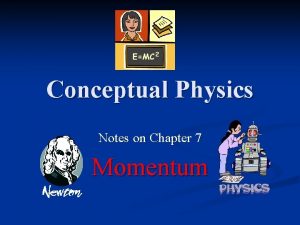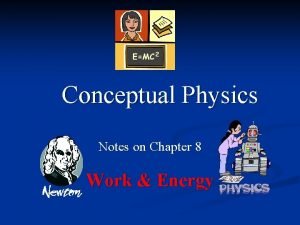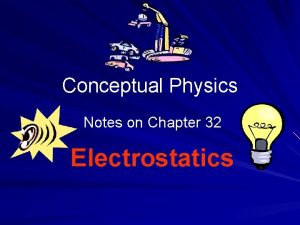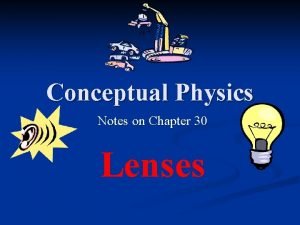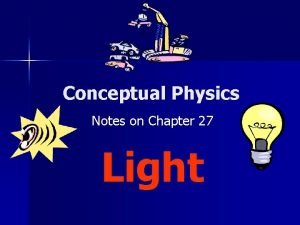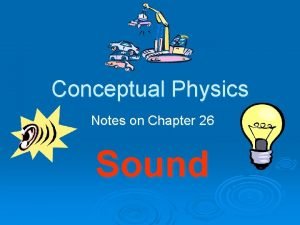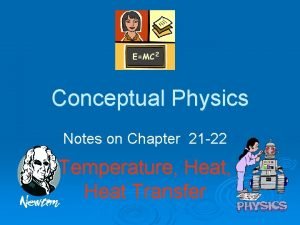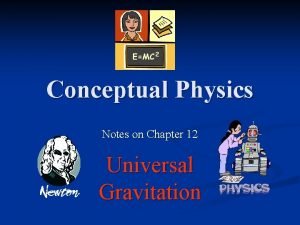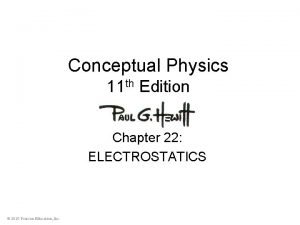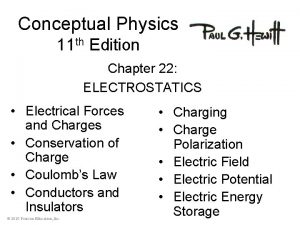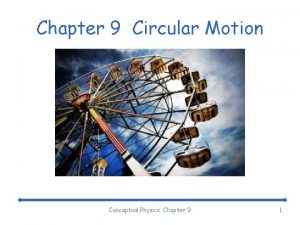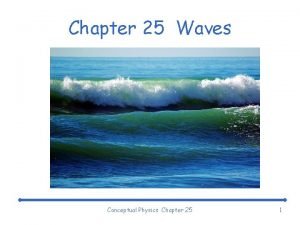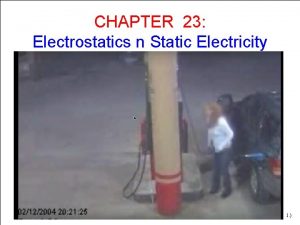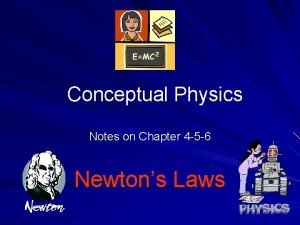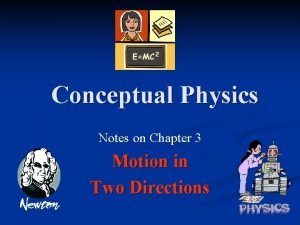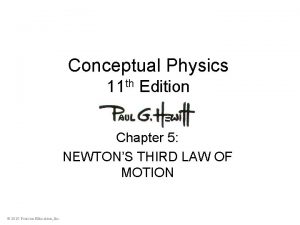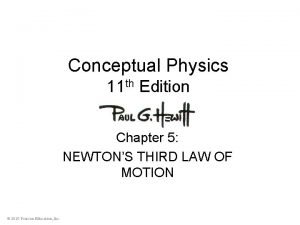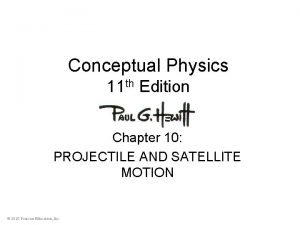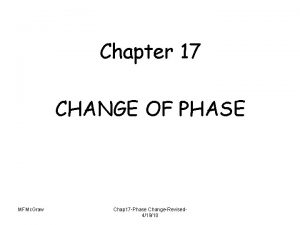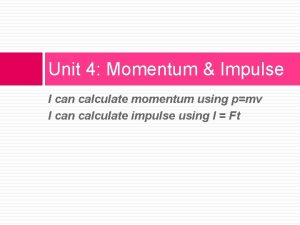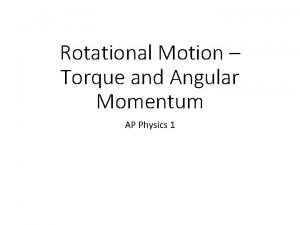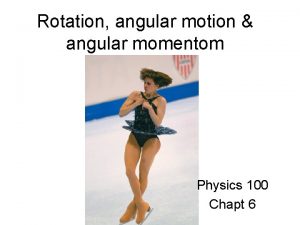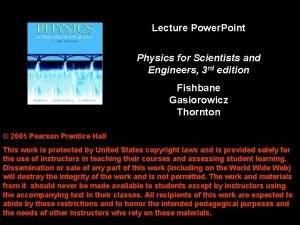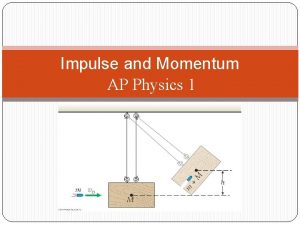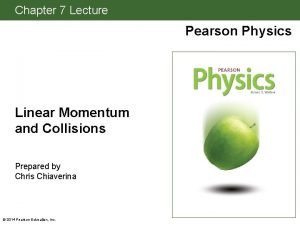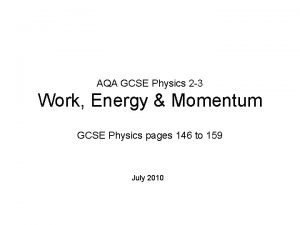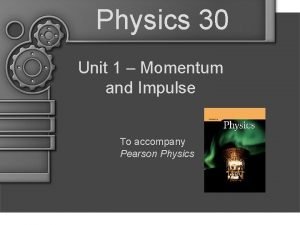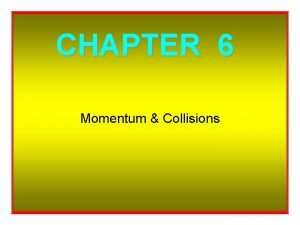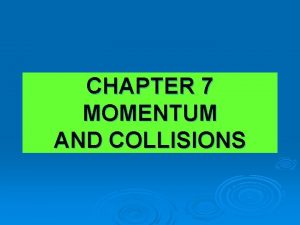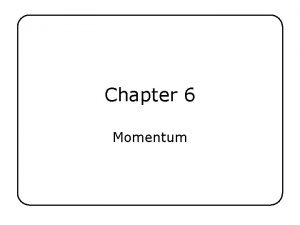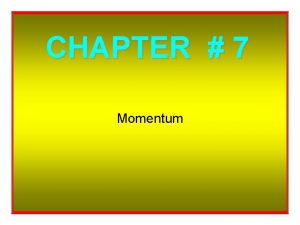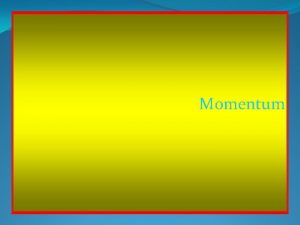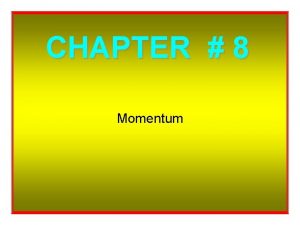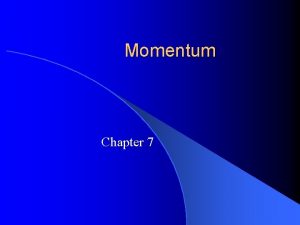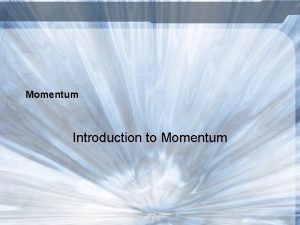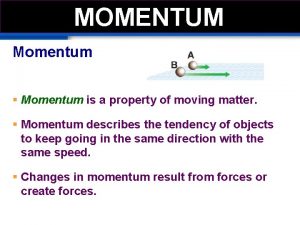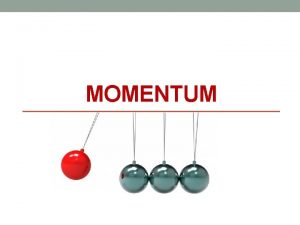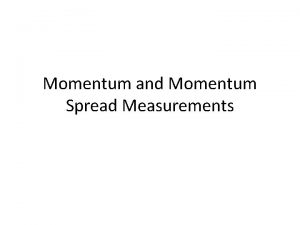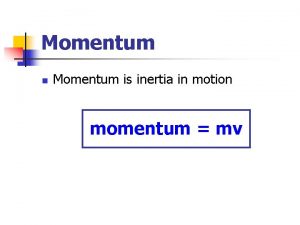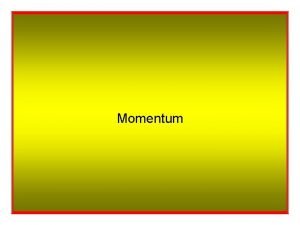Conceptual Physics 11 th Edition Chapter 6 MOMENTUM




































- Slides: 36

Conceptual Physics 11 th Edition Chapter 6: MOMENTUM © 2010 Pearson Education, Inc.

This lecture will help you understand: • • Momentum Impulse Changes Momentum Bouncing Conservation of Momentum Collisions More Complicated Collisions © 2010 Pearson Education, Inc.

Momentum • a property of moving things • means inertia in motion • more specifically, mass of an object multiplied by its velocity • in equation form: Momentum = mass velocity © 2010 Pearson Education, Inc.

Momentum Example: • A moving boulder has more momentum than a stone rolling at the same speed. • A fast boulder has more momentum than a slow boulder. • A boulder at rest has no momentum. © 2010 Pearson Education, Inc.

Momentum CHECK YOUR NEIGHBOR A moving object has 1. 2. 3. 4. momentum. energy. speed. All of the above. © 2010 Pearson Education, Inc.

Momentum CHECK YOUR ANSWER A moving object has 1. 2. 3. 4. momentum. energy. speed. All of the above. Comment: We will see in the next chapter that energy in motion is called kinetic energy. © 2010 Pearson Education, Inc.

Momentum CHECK YOUR NEIGHBOR When the speed of an object is doubled, its momentum 1. 2. 3. 4. remains unchanged in accord with the conservation of momentum. doubles. quadruples. decreases. © 2010 Pearson Education, Inc.

Momentum CHECK YOUR ANSWER When the speed of an object is doubled, its momentum 1. 2. 3. 4. remains unchanged in accord with the conservation of momentum. doubles. quadruples. decreases. © 2010 Pearson Education, Inc.

Impulse • Product of force and time (force time) • In equation form: Impulse = Ft Example: • A brief force applied over a short time interval produces a smaller change in momentum than the same force applied over a longer time interval. or • If you push with the same force for twice the time, you impart twice the impulse and produce twice the change in momentum. © 2010 Pearson Education, Inc.

Impulse Changes Momentum The greater the impulse exerted on something, the greater the change in momentum. • In equation form: Ft = (mv) © 2010 Pearson Education, Inc.

Impulse Changes Momentum CHECK YOUR NEIGHBOR When the force that produces an impulse acts for twice as much time, the impulse is 1. 2. 3. 4. not changed. doubled. quadrupled. halved. © 2010 Pearson Education, Inc.

Impulse Changes Momentum CHECK YOUR ANSWER When the force that produces an impulse acts for twice as much time, the impulse is 1. 2. 3. 4. not changed. doubled. quadrupled. halved. © 2010 Pearson Education, Inc.

Impulse Changes Momentum • Case 1: increasing momentum – Apply the greatest force for as long as possible and you extend the time of contact. – Force can vary throughout the duration of contact. Examples: • Golfer swings a club and follows through. • Baseball player hits a ball and follows through. © 2010 Pearson Education, Inc.

Impulse Changes Momentum CHECK YOUR NEIGHBOR A cannonball shot from a cannon with a long barrel will emerge with greater speed because the cannonball receives a greater 1. 2. 3. 4. average force. impulse. Both of the above. None of the above. © 2010 Pearson Education, Inc.

Impulse Changes Momentum CHECK YOUR ANSWER A cannonball shot from a cannon with a long barrel will emerge with greater speed because the cannonball receives a greater 1. 2. 3. 4. average force. impulse. Both of the above. None of the above. Explanation: The average force on the cannonball will be the same for a short- or long-barreled cannon. The longer barrel provides for a longer time for the force to act, and therefore, a greater impulse. (The long barrel also provides a longer distance for the force to act, providing greater work and greater kinetic energy to the cannonball. ) © 2010 Pearson Education, Inc.

Impulse Changes Momentum • Case 2: decreasing momentum over a long time – extend the time during which momentum is reduced © 2010 Pearson Education, Inc.

Impulse Changes Momentum CHECK YOUR NEIGHBOR A fast-moving car hitting a haystack or a cement wall produces vastly different results. 1. Do both experience the same change in momentum? 2. Do both experience the same impulse? 3. Do both experience the same force? 1. 2. 3. 4. Yes for all three Yes for 1 and 2 No for all three No for 1 and 2 © 2010 Pearson Education, Inc.

Impulse Changes Momentum CHECK YOUR ANSWER A fast-moving car hitting a haystack or hitting a cement wall produces vastly different results. 1. Do both experience the same change in momentum? 2. Do both experience the same impulse? 3. Do both experience the same force? 1. 2. 3. 4. Yes for all three Yes for 1 and 2 No for all three No for 1 and 2 Explanation: Although stopping the momentum is the same whether done slowly or quickly, the force is vastly different. Be sure to distinguish among momentum, impulse, and force. © 2010 Pearson Education, Inc.

Impulse Changes Momentum CHECK YOUR NEIGHBOR When a dish falls, will the change in momentum be less if it lands on a carpet than if it lands on a hard floor? (Careful!) 1. 2. 3. 4. No, both are the same. Yes, less if it lands on the carpet. No, less if it lands on a hard floor. No, more if it lands on a hard floor. © 2010 Pearson Education, Inc.

Impulse Changes Momentum CHECK YOUR ANSWER When a dish falls, will the change in momentum be less if it lands on a carpet than if it lands on a hard floor? (Careful!) 1. No, both are the same. 2. 3. 4. Yes, less if it lands on the carpet. No, less if it lands on a hard floor. No, more if it lands on a hard floor. Explanation: The momentum becomes zero in both cases, so both change by the same amount. Although the momentum change and impulse are the same, the force is less when the time of momentum change is extended. Be careful to distinguish among force, impulse, and momentum. © 2010 Pearson Education, Inc.

Impulse Changes Momentum Examples: When a car is out of control, it is better to hit a haystack than a concrete wall. Physics reason: Same impulse either way, but extension of hitting time reduces the force. © 2010 Pearson Education, Inc.

Impulse Changes Momentum Example (continued): In jumping, bend your knees when your feet make contact with the ground because the extension of time during your momentum decrease reduces the force on you. In boxing, ride with the punch. © 2010 Pearson Education, Inc.

Impulse Changes Momentum • Case 3: decreasing momentum over a short time – short time interval produces large force. Example: Karate expert splits a stack of bricks by bringing her arm and hand swiftly against the bricks with considerable momentum. Time of contact is brief and force of impact is huge. © 2010 Pearson Education, Inc.

Bouncing Impulses are generally greater when objects bounce. Example: Catching a falling flower pot from a shelf with your hands. You provide the impulse to reduce its momentum to zero. If you throw the flower pot up again, you provide an additional impulse. This “double impulse” occurs when something bounces. © 2010 Pearson Education, Inc.

Bouncing Pelton wheel designed to “bounce” water when it makes a U-turn on impact with the curved paddle © 2010 Pearson Education, Inc.

Conservation of Momentum Law of conservation of momentum: In the absence of an external force, the momentum of a system remains unchanged. © 2010 Pearson Education, Inc.

Conservation of Momentum Examples: • When a cannon is fired, the force on the cannonball inside the cannon barrel is equal and opposite to the force of the cannonball on the cannon. • The cannonball gains momentum, while the cannon gains an equal amount of momentum in the opposite direction—the cannon recoils. When no external force is present, no external impulse is present, and no change in momentum is possible. © 2010 Pearson Education, Inc.

Conservation of Momentum Examples (continued): • Internal molecular forces within a baseball come in pairs, cancel one another out, and have no effect on the momentum of the ball. • Molecular forces within a baseball have no effect on its momentum. • Pushing against a car’s dashboard has no effect on its momentum. © 2010 Pearson Education, Inc.

Collisions For all collisions in the absence of external forces, • net momentum before collision equals net momentum after collision. • in equation form: (net mv)before = (net mv)after © 2010 Pearson Education, Inc.

Collisions Elastic collision – occurs when colliding objects rebound without lasting deformation or any generation of heat. © 2010 Pearson Education, Inc.

Collisions Inelastic collision – occurs when colliding objects result in deformation and/or the generation of heat. © 2010 Pearson Education, Inc.

Collisions Example of elastic collision: single car moving at 10 m/s collides with another car of the same mass, m, at rest From the conservation of momentum, (net mv)before = (net mv)after (m 10)before = (2 m V)after V = 5 m/s © 2010 Pearson Education, Inc.

Collisions CHECK YOUR NEIGHBOR Freight car A is moving toward identical freight car B that is at rest. When they collide, both freight cars couple together. Compared with the initial speed of freight car A, the speed of the coupled freight cars is 1. 2. 3. 4. the same. half. twice. None of the above. © 2010 Pearson Education, Inc.

Collisions CHECK YOUR ANSWER Freight car A is moving toward identical freight car B that is at rest. When they collide, both freight cars couple together. Compared with the initial speed of freight car A, the speed of the coupled freight cars is 1. 2. 3. 4. the same. half. twice. None of the above. Explanation: After the collision, the mass of the moving freight cars has doubled. Can you see that their speed is half the initial velocity of freight car A? © 2010 Pearson Education, Inc.

More Complicated Collisions • Sometimes the colliding objects are not moving in the same straight line. • In this case you create a parallelogram of the vectors describing each initial momentum to find the combined momentum. • Example: collision of two cars at a corner © 2010 Pearson Education, Inc.

More Complicated Collisions Another example: A firecracker exploding; the total momentum of the pieces after the explosion can be added vectorially to get the initial momentum of the firecracker before it exploded. © 2010 Pearson Education, Inc.
 Chapter 6 momentum changing momentum
Chapter 6 momentum changing momentum Conceptual momentum
Conceptual momentum University physics with modern physics fifteenth edition
University physics with modern physics fifteenth edition Conceptual physics notes
Conceptual physics notes Conceptual physics chapter 35
Conceptual physics chapter 35 Chapter 33 electric fields and potential
Chapter 33 electric fields and potential Conceptual physics electrostatics
Conceptual physics electrostatics Chapter 30 lenses
Chapter 30 lenses Chapter 27 light conceptual physics
Chapter 27 light conceptual physics Conceptual physics chapter 26
Conceptual physics chapter 26 Conceptual physics chapter 21
Conceptual physics chapter 21 Conceptual physics chapter 13 universal gravitation
Conceptual physics chapter 13 universal gravitation Conceptual physics chapter 22 answers
Conceptual physics chapter 22 answers Conceptual physics chapter 22 electrostatics
Conceptual physics chapter 22 electrostatics Chapter 9 circular motion answers
Chapter 9 circular motion answers Conceptual physics chapter 25
Conceptual physics chapter 25 Electricity
Electricity Conceptual physics chapter 4
Conceptual physics chapter 4 Conceptual physics chapter 3
Conceptual physics chapter 3 Slightly tilted wings of airplanes deflect
Slightly tilted wings of airplanes deflect Conceptual physics chapter 5 newton's third law of motion
Conceptual physics chapter 5 newton's third law of motion Conceptual physics chapter 3 linear motion
Conceptual physics chapter 3 linear motion Chapter 10 projectile and satellite motion
Chapter 10 projectile and satellite motion Conceptual physics chapter 17 change of phase answers
Conceptual physics chapter 17 change of phase answers Using mis (10th edition) 10th edition
Using mis (10th edition) 10th edition Report
Report Physics 03-01 work and the work-energy theorem
Physics 03-01 work and the work-energy theorem Momentum units
Momentum units Theorem of angular momentum
Theorem of angular momentum Iw^2 physics
Iw^2 physics Ap physics 1 momentum equations
Ap physics 1 momentum equations Torque direction rule
Torque direction rule Ap physics momentum
Ap physics momentum What is momentum in physics
What is momentum in physics Momentum definition in physics
Momentum definition in physics Momentum physics gcse
Momentum physics gcse Physics 30 momentum and impulse
Physics 30 momentum and impulse

